
|
This is the R/V Karluk, a research vessel that can be used by many different
projects for a variety of tasks. Included is specific
information on:
The R/V Karluk is at home in icy waters.
|
|
The R.V. Karluk is a 12.8 m (42 ft.) fiberglass, tunnel drive research vessel
built on the hull of the popular Alaska Chignik seigner. Ice strengthened,
she was designed to accommodate four on extended, self contained, geophysical,
sampling, and diving cruises in remote Arctic waters, making efficient use
of all space for storage of supplies, spare parts, and provisions.
The R.V.
Karluk was used in the Arctic from 1975 to 1987, ranging from the Yukon
Delta, Bering Sea, to the Mackenzie Delta, Canada, and winterized in various
places on land. In 1989, she was brought to Seattle and stored, but returned
from 1990 to 1993 for work in southeast and south-central Alaska. In 1995
she was used in Puget Sound, Washington.
|
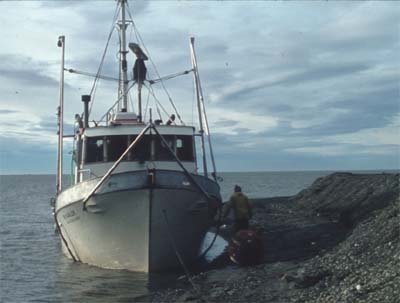
|
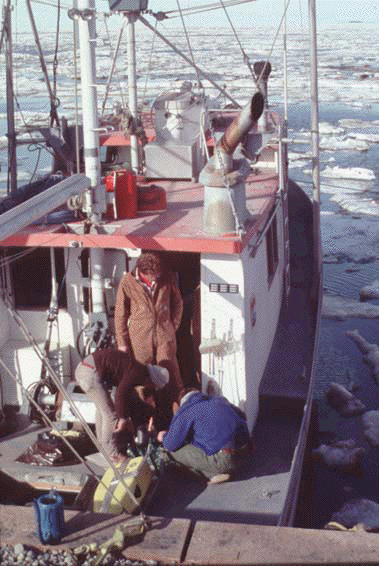
Preparing gear at the onset of spring ice breakup near the North slope
of Alaska in 1983.
|
Living and working spaces are well insulated and heated by a diesel fuel
cooking/baking stove. They include four bunks, lockers, toilet/shower, galley,
and dinette for four. The deck house has about 3.7 m (12 linear ft.) of
counter space, with an additional 1.8 m (6 ft.) in the wheel house for geophysical
and navigational equipment.
A hull-mounted transducer and sea chest with
a 3.5 and 7 kHz transducer exist, as well as a bow sprit for towing a sonar
fish in undisturbed very shallow water. The vessel is equipped with stabilizer
booms, which also serve to tow hydrophones and boomers. It carries 7 kW
and 15 kW diesel generators, and is capable of doing seismic and sonar surveys
all day long at 3.5 knots. With its hydraulic winch and main boom the boat
seved well to take many vibrocores over the side, using a device weighing
about 780 kg (2,000 lbs.).
The R.V. Karluk can be operated with controls
above the wheel house, and has a lookout in the mast. The 8V71 GMC main
engine propels the boat at 8.5 knots, and with a fuel tank capacity of over
3460 L (900 gals.) it has a range of about 1670 kms (900 nmi.). Keel coolers
enable the boat to operate in sediment-laden or eel grass infested waters,
or while ice crystals are forming slush in the water column. With its rugged
hull and versatile boom, the boat can be re-supplied and fueled from alongside
a gravel beach in remote regions.
|
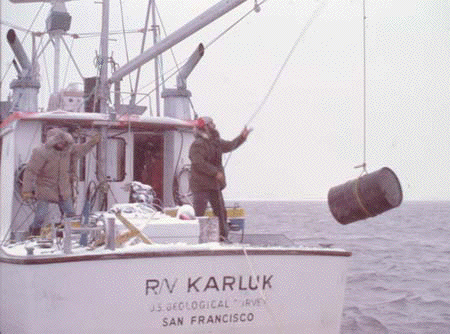
Buying diesel fuel from Oliktok DEW Line site on the North Slope in
late August, 1975. Note snow-covered UNIBOOM sled on deck.
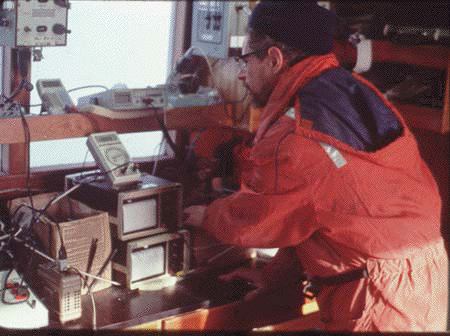
Fine-tuning electric resistivity gear in the Deck House during an
offshore study of permafrost in the Beaufort Sea in 1982
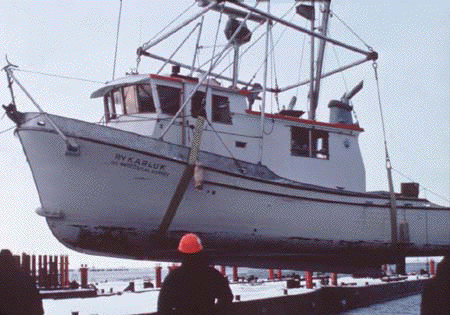
Hauling out for the winter in Prudehoe Bay at the close of the Karluk's
first season in 1975. Gravel bars obviously are abrasive on the bottom paint.
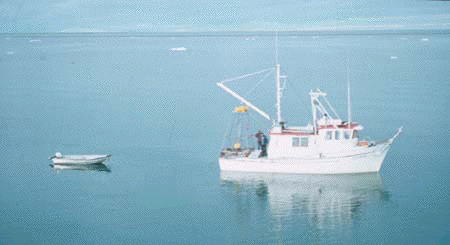
Loaded with vibrocorer for sampling off the North Slope of Alaska
in 1976. Launch tags along like an obedient puppy dog.
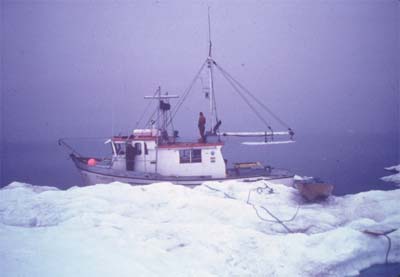
Pumping drinking water from a fresh water pool on multi-year ice
flow in the Beaufort Sea, 1978. Note polar bear guard on cabin top.

Taking care of needed repairs.
|


|
|














